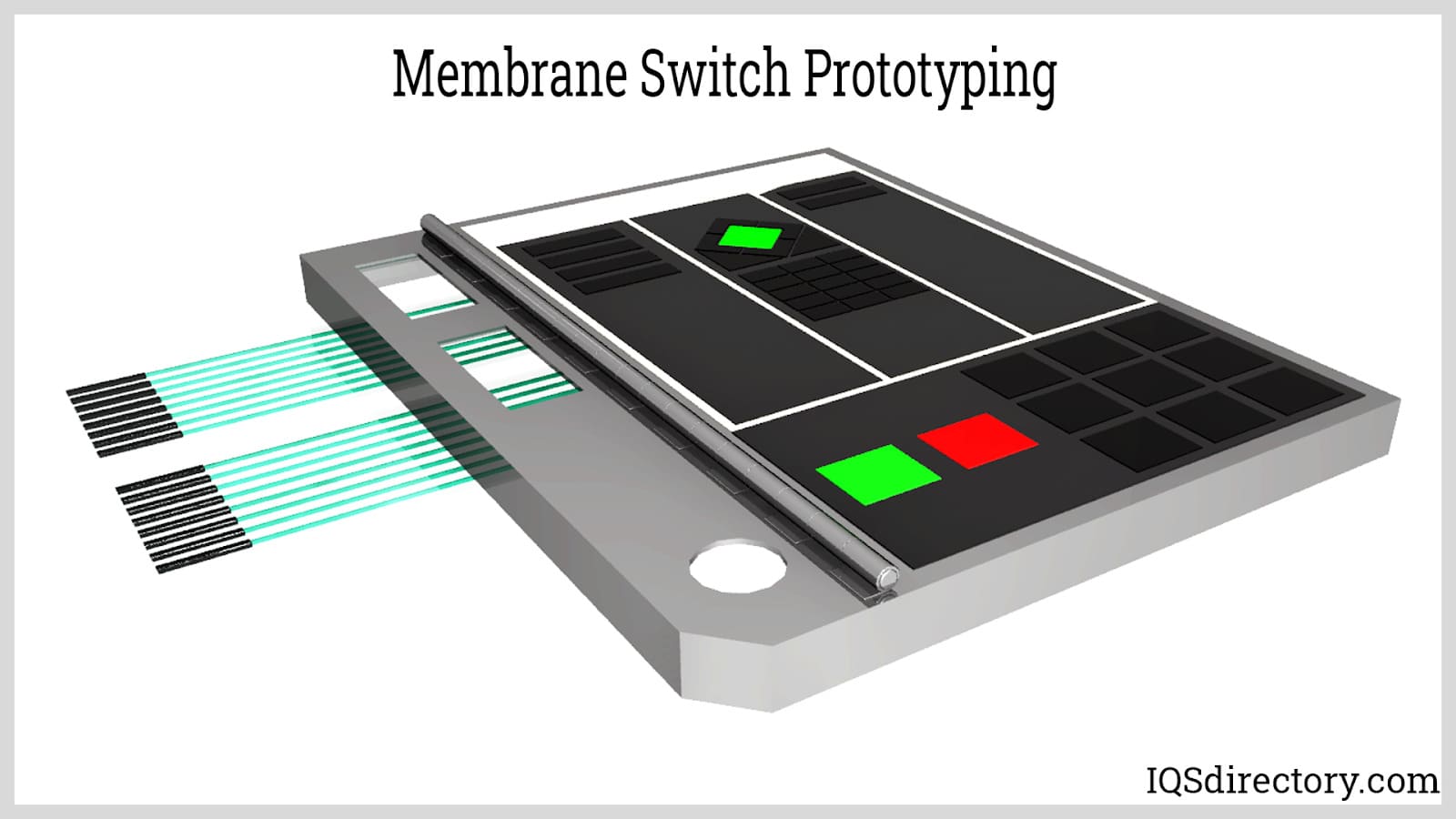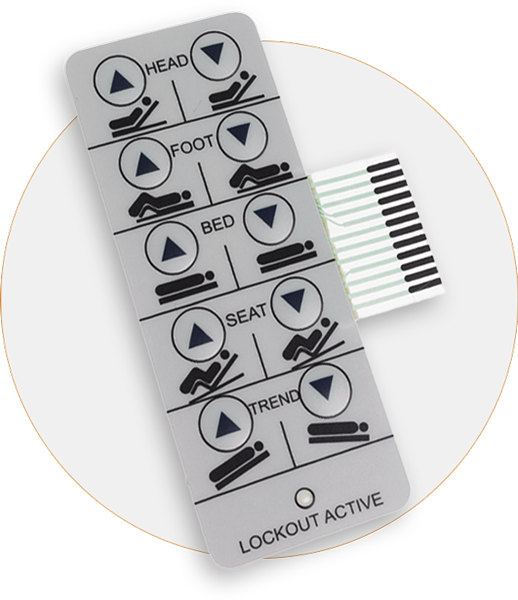Membrane Switch Manufacturer Focused on User-Friendly Design
Checking Out the Production Refine of Membrane Switch for Various Industries
The production procedure of Membrane buttons is an intricate venture that demands accuracy and interest to information. From picking suitable materials to applying extensive quality control measures, each action plays an important role in making certain performance. Various sectors, including clinical and vehicle, depend on these parts for their special applications. Understanding the details of this process discloses considerable understandings right into how these buttons are produced and their effect throughout diverse fields.
Understanding Membrane Switches: A Summary

Trick Products Utilized in Membrane Switch Production
In Membrane button production, the option of essential products substantially affects performance and toughness. Conductive materials, adhesives, and finishings play important roles, while substratum choice affects overall efficiency and reliability. Recognizing these elements is vital for optimizing the layout and production of Membrane switches.
Conductive Products Summary
Conductive materials play a crucial role in the capability of Membrane buttons, guaranteeing reliable electric links within the gadget. Commonly utilized materials include silver, copper, and carbon-based inks, each offering unique benefits. Silver is favored for its high conductivity and toughness, making it suitable for applications needing durable performance. Copper, while somewhat much less conductive than silver, is an economical alternative commonly used in printed circuits. Carbon-based inks give a versatile alternative, suitable for applications where versatility and reduced prices are prioritized, although they have reduced conductivity contrasted to metal alternatives. The choice of conductive products straight impacts the overall dependability, life-span, and performance of the Membrane switch, making it an important factor to consider in the production procedure.
Adhesives and Coatings
Adhesives and finishings are important elements in the manufacturing of Membrane switches, supplying vital bonding and safety residential properties. These products assure that numerous layers of the button, consisting of visuals overlays and wiring, stick firmly to one another, improving longevity and functionality. Typically utilized adhesives include pressure-sensitive adhesives (PSAs) and epoxy-based formulations, which provide strong adhesion and resilience. Coatings, such as polyurethane or acrylic, offer to shield versus environmental aspects, consisting of dampness, abrasion, and chemicals. In addition, finishes can enhance tactile feedback and aesthetic charm, adding to the general user experience. The choice of appropriate adhesives and coatings is crucial for enhancing efficiency and long life in varied applications throughout numerous industries, guaranteeing that Membrane switches over fulfill particular operational needs.
Substrate Choice Elements
Substrate selection plays a necessary role in the manufacturing of Membrane switches, as it greatly influences their total performance and longevity. Key materials such as polyester, polycarbonate, and versatile published motherboard (FPCBs) are commonly utilized for their distinctive residential properties. Polyester is favored for its cost-effectiveness and resistance to abrasion, making it ideal for applications with high wear. Polycarbonate offers premium quality and impact resistance, suitable for settings calling for high exposure. FPCBs provide improved flexibility and are typically utilized in complicated designs. The selection of substratum also impacts factors like thermal security, chemical resistance, and convenience of printing. Eventually, choosing the appropriate substrate is crucial for making sure the performance and long life of Membrane switches across different markets.
The Layout Process of Membrane Switches
The layout process of Membrane buttons is an important phase that significantly affects the performance and looks of the end product - membrane switch manufacturer. It begins with specifying the details needs of the application, consisting of measurements, button design, and tactile feedback choices. Designers should think about user communication, making sure that the button is instinctive and accessible.Next, materials are picked based on durability, versatility, and environmental resistance. The combination of graphics and branding components is also vital, as it boosts aesthetic appeal and communication. Prototyping permits for repetitive screening, allowing modifications based on customer responses and performance evaluations.Additionally, the layout must account for the electrical parts, such as ports and circuits, making certain reliability and convenience of usage. Eventually, an effective design harmonizes capability, appearances, and customer experience, leading the way for reliable manufacturing and lasting performance in numerous markets
Printing Strategies for Membrane Switches Over
The printing methods used in Membrane switch production play a crucial function in determining the end product's top quality and functionality. Display printing provides benefits such as sturdiness and vibrant shade application, while electronic printing developments give versatility and accuracy in design. Recognizing these methods can considerably impact the general performance of Membrane switches in numerous applications.
Screen Printing Benefits
Countless benefits make display publishing a recommended strategy for creating Membrane switches. This method enables premium, detailed designs and vivid shades, which are crucial for customer interface applications. Display printing is especially efficient for using thick ink layers, boosting durability and responsive responses. Furthermore, it uses outstanding adhesion to numerous substratums, guaranteeing durability in demanding atmospheres. The procedure is cost-effective for large manufacturing runs, as it decreases configuration time and waste. Display printing supports a wide variety of inks, including specialized and UV-curable options, making it possible for adaptability in design. Its capability to produce constant results throughout numerous systems makes it a dependable selection for producers intending for quality and performance in Membrane switch manufacturing.
Digital Printing Innovations

Improvements in electronic printing technology are transforming the production of Membrane buttons, providing suppliers innovative services that improve style adaptability and efficiency. Digital printing permits high-resolution graphics go to my site and detailed designs, allowing custom-made branding and capability without the constraints of traditional methods. This technique decreases arrangement times and prices, assisting in shorter production runs and minimal waste, making it ideal for services with differing demands. Furthermore, developments in ink solutions give far better durability and adhesion, ensuring long life in numerous settings. As markets significantly seek intricate and tailored styles, digital printing stands out as a vital technique, establishing a brand-new requirement in Membrane button manufacturing. The integration of these technologies placements producers to meet advancing market requires effectively.
Setting up and Layering of Membrane Switch Parts
Careful setting up and layering of Membrane button components are essential to assuring functionality and durability. This process starts with the precise positioning of various layers, consisting of the graphic overlay, sticky, circuit layer, and backing product. Each component needs to be meticulously positioned to keep electric honesty and user interface responsiveness.During assembly, conductive traces are used to the circuit layer, normally made from materials like polyester or polycarbonate. This layer is important, as it transmits signals when pressure is used. The adhesive utilized for bonding these layers is additionally chosen for its capability to sustain environmental anxieties while maintaining a protected bond.Heat and stress are often applied throughout the setting up process to determine that the layers stick effectively without compromising the performance of the button. Ultimately, attention is provided to the edge securing to shield versus moisture and contaminants, protecting the durability of the Membrane switch in different commercial applications.
Quality Assurance Steps in Membrane Switch Production
Quality control measures play a vital function in guaranteeing the dependability and efficiency of Membrane switches over following the assembly and layering of their components. In the production procedure, several essential evaluations are conducted to copyright quality criteria. These consist of visual evaluations for defects in printing and sticky application, along with practical tests to verify the responsiveness of each switch.Additionally, ecological testing is carried out to assess the buttons' longevity versus temperature variations and moisture exposure. Suppliers usually carry out statistical process control (copyright) strategies to keep an eye on production uniformity, enabling very early detection of anomalies.Furthermore, traceability systems are developed to track elements and products, making sure accountability and promoting recalls if essential. Calibration of devices and adherence to sector requirements are additionally crucial to maintaining product honesty. Collectively, these quality assurance measures secure the efficiency of Membrane switches over across different applications, ultimately improving consumer satisfaction.
Applications of Membrane Switches Over Across Different Industries
Membrane switches are used across a varied array of markets, showcasing their versatility and adaptability. In the clinical industry, they supply water resistant and reliable interfaces for gadgets such as diagnostic tools and mixture pumps, ensuring hygiene and ease of use. The automotive industry utilizes Membrane switches for dashboard controls, allowing smooth communication in between the chauffeur and automobile systems.In consumer electronic devices, these buttons are located in devices and portable tools, supplying a streamlined, modern-day visual while enhancing functionality. Industrial applications also leverage Membrane switches over for equipment control board, where durability and resistance to extreme problems are essential.Furthermore, the aerospace and protection fields make use of Membrane switches for cockpit instrumentation and communication systems, prioritizing dependability and efficiency under extreme conditions. Overall, Membrane switches play an essential role in enhancing the customer experience and functional performance throughout different domains.
Regularly Asked Inquiries
For how long Does It Take to Make a Membrane Layer Switch?
The production time for a membrane layer switch generally varies from a few days their explanation to several weeks - membrane switch manufacturer. Variables affecting this duration consist of style complexity, product availability, and manufacturing volume, all impacting the total timeline substantially
What Is the Normal Life Expectancy of a Membrane Layer Switch?
The regular life expectancy of a membrane button typically varies from 1 to 5 million actuations, depending upon factors such as worldly quality, ecological conditions, and use frequency, substantially affecting durability and general performance.
Can Membrane Switches Be Personalized for Specific Applications?
Membrane buttons can indeed be personalized for specific applications. Their style adaptability permits modifications in dimension, shape, colors, and graphics, making sure compatibility with distinct needs throughout various industries and enhancing performance and user experience.

Are Membrane Switches Over Environmentally Friendly?
The browse around these guys ecological influence of Membrane changes differs. Some products made use of may not be environment-friendly, while advancements in producing procedures are significantly focusing on sustainability, aiming to decrease waste and promote recyclable parts in their manufacturing.
What Are the Common Failing Modes of Membrane Switches?
Common failure modes of Membrane switches include delamination, sticky failing, damage from use, moisture ingress, and electrical failures. These issues can significantly impact performance, performance, and life expectancy in different applications throughout various markets. Membrane switches can be personalized to fit certain style demands, such as form, performance, and size, making them highly adaptable.The construction usually involves multiple layers, including a visuals overlay, adhesive, and a circuit layer, which work together to develop a smooth individual experience. In Membrane button production, the option of essential materials greatly affects performance and toughness. The vehicle industry uses Membrane switches for control panel controls, allowing smooth communication between the vehicle driver and automobile systems.In consumer electronic devices, these switches are found in devices and handheld tools, using a sleek, contemporary aesthetic while boosting functionality. Industrial applications additionally take advantage of Membrane changes for equipment control panels, where resilience and resistance to harsh problems are essential.Furthermore, the aerospace and defense fields utilize Membrane buttons for cockpit instrumentation and interaction systems, prioritizing dependability and performance under extreme conditions. Membrane buttons can certainly be tailored for particular applications.